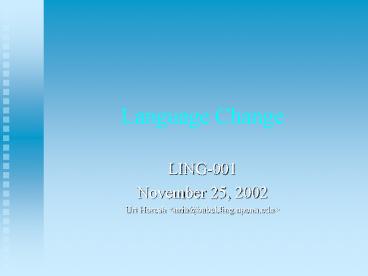Language Change - PowerPoint PPT Presentation
1 / 20
Title:
Language Change
Description:
The major chain shifts of North American English (Labov 2002) Family tree model of historical relationships ... I. Apical -[r], either flapped or trilled ... – PowerPoint PPT presentation
Number of Views:54
Avg rating:3.0/5.0
Title: Language Change
1
Language Change
- LING-001
- November 25, 2002
- Uri Horesh lturih_at_babel.ling.upenn.edugt
2
LING-001 Fall 2001(Liberman)
3
The major chain shifts of North American
English(Labov 2002)
4
Family tree model of historical relationships
between languages and dialects over time (Sankoff
2002)
X
Language 1
time
Y
C
A
B
Language 3
Language 2
5
Snake River Valley, Morobe Province,
Papua New Guinea
Buweyew
Vagau
Wins
Mambump
MAPOS BUANG (11 villages)
Muniau
Reges
Bugwev
Mapos
HEADWATERS BUANG
Papekone
B
C
MANGGA BUANG (8 villages)
A
Mangga
6
Two proposals for the classification of Semitic
languages
Traditional view (e.g., Blau)
Hetzrons proposal
7
Montreal r ? R in real and apparent time
a trend and panel comparison
Gillian Sankoff, University of Pennsylvania Hélène
Blondeau, University of Ottawa
8
Apparent Time
Relies on the finding that the linguistic traits
of an age cohort will remain the same over time
9
Major variants of (r) in Montreal FrenchI.
Apical -r, either flapped or trilledII.
Posterior- R either a uvular trill or a velar
fricativeIII. Vocalized -typical of codas with
final diphthong/lengthened vowel
(r),e.g.. boire, père, pour, sûrIV. Deleted -
typical of final clusters, e.g. autre otV.
Retroflex (American /r/) rare variant occurring
sporadically in English-origin or English-
associated words, e.g. Steinberg, Montréal
10
R/(Rr) by age for 113 speakers in 1971
(Clermont Cedergren 1979)
11
S-curve as a model for the progress over time of
a linguistic innovation
12
32 Panel Speakers, R1971 - 1984
13
Mean percentage R use over time, Panel and
Trend samples
Panel Speakers over time Two separate Trend samples
1984 63.9 80.4
1971 52.0 56.0
Mean increase 11.9 24.4
Increase over 1971 level 23 44
14
R for 32 Trend Speakers,1971and for 32
matched Trend Speakers, 1984
15
Patterns of change in the individual and the
community adapted from Labov 199483.
Synchronic Pattern Interpretation Individual Community
Flat 1. Stability stable stable
Monotonic slope with age 2a. Age-grading unstable stable
Monotonic slope with age 2b. Lifespan change unstable unstable
Monotonic slope with age 3. Generational change stable unstable
Flat 4. Communal change unstable unstable
Apparent Time
16
Conclusions
- I. The r ? R change
- Change in the community is a result of
individual speakers, especially younger speakers,
being added to the pool of majority-users or
categorical users of R.
17
Conclusions
- II. Apparent time
- The apparent time interpretation was correct in
indicating a rapid change in progress in
/r/-pronunciation in Montreal on the basis of the
1971 data. - However, it underestimated the rate of progress
of the change. Insofar as 1/3 of the older
speakers in our sample progressed significantly
in the direction of the change, their starting
points as young speakers would have been much
less far along in the course of change than the
point they have reached as adults. Thus, the
distance they have travelled is greater than an
assumption of stability after initial acquisition
would lead us to believe.
18
Conclusions
- III. Trend and Panel Studies
- Our results confirm the view that Trend
studies yield the most accurate view of change in
progress. The Panel study, however, gave unique
insight into the relationship between language
change at the level of the community, and
language change as experienced by individual
speakers across their lifespans.
19
Conclusions
- IV. Critical Age
- A majority of speakers showed stability in
adult life, but a sizeable minority progressed
significantly in the direction of the change. - We believe that this variability in later life is
characteristic of later language learning in
general, and that our results are consonant with
those of second-language and second-dialect
acquisition. - We believe that different levels of linguistic
organization are differentially susceptible to
alteration in later life, and that this
differential linguistic lability relates to the
modularity of language. Clearly an important
topic for future research!
20
Dylan 1963
- The line it is drawn
- The curse it is cast
- The slow one now
- Will later be fast
- As the present now
- Will later be past
- The order is
- Rapidly fadin.
- And the first one now
- Will later be last
- For the times they are a-changin.































